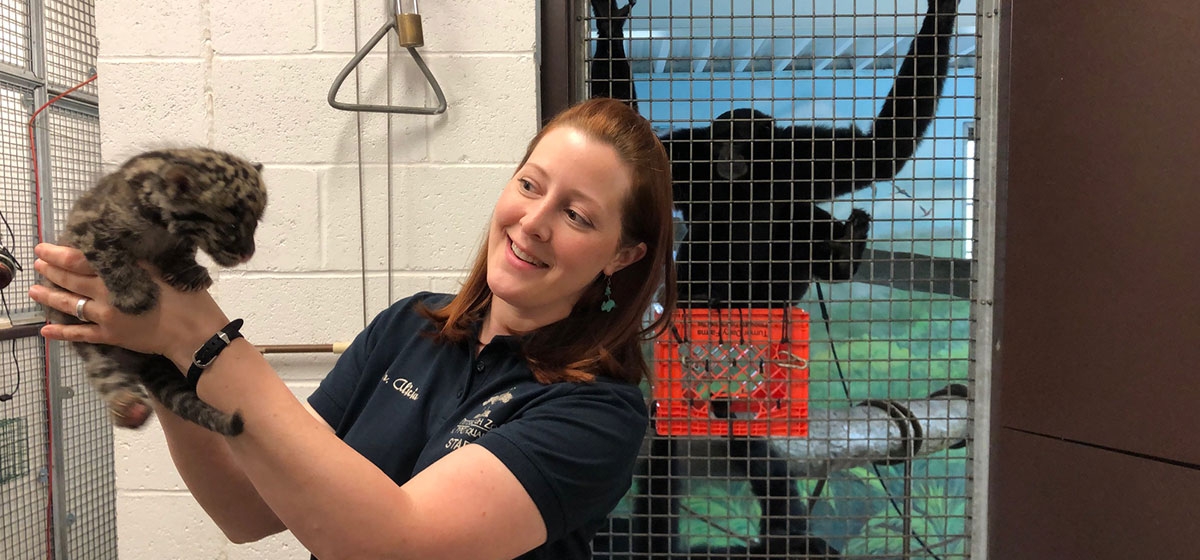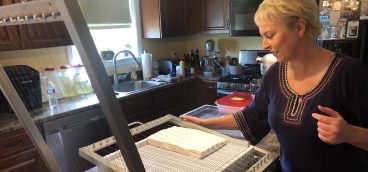Their Patients Are Animals

It’s cold. Damp. Overcast and gray outside. Early on a Tuesday morning and the lions are roaring.
“Communicating,” says Kathy, the lead mammal keeper. “That’s how lions communicate.”
It’s barely 9:30 a.m. and people are already walking through the Pittsburgh Zoo & PPG Aquarium, despite the clouds and the rain. Moms pushing strollers and dads holding sticky hands and now, the flamingos have started chattering.
“Squawking. Squabbling. Arguing. Pick a verb,” Kathy says. “It’s breeding season. And we just put fresh dirt in the palms and they’re all fighting over it. They like to use it for their nests. Oh, there’s Dr. Ginger.”
Dr. Ginger is walking towards the tiger exhibit. With her are Libbi the vet tech and her traveling medical supplies and Lisa, vet intern from the United Kingdom, who is lugging a heavy backpack, wearing a green Royal Veterinarian College University of London polo tee shirt and freezing.
“It’s so cold,” she says, notepad in hand. “I didn’t bring a jacket.”
On the agenda this morning: tigers, Komodo dragon, pangolin, clouded leopard, penguin eggs, sea horse, goats. “Yeah, there’s no such thing as a normal day for us,” says Dr. Alicia.
There are five women who make up the zoo’s veterinarian team: Dr. Ginger and Dr. Alicia, who are both on call 24/7, vet techs Libbi and Kristine, and Erin, the hospital keeper. Six women, if you count Lisa the intern. This isn’t the usual deal. There aren’t many zoos that employ a veterinarian team made up entirely of women. “It’s a more physical job. We’re not dealing with domestic animals. Plus, anesthetizing is dangerous,” says Dr. Ginger. “When we’re anesthetizing a lion or a polar bear, we’re the first ones into the stall. We’ve had an all-woman team for the past 10 years, although not by design. We pick the best person to do the job.”
Right now, Dr. Ginger is leading Libbi and Lisa back to check on Tesha, an Amur Tiger who lives with her brother, Andre. Tesha and Andre get along great… a little too great.
“Well, in captivity, lines can get crossed,” Dr. Ginger explains as she opens the 10-foot tall gate. “So, we had to think about birth control.” Besides the whole brother/sister thing, Tesha was born with a congenital brain malformation, which may or may not be genetic, so the zoo didn’t want to breed her.
“We gave her an ovarian hysterectomy. Spay,” Dr. Ginger explains. But you can’t exactly put a cone collar on a big cat while her incision heals. “Post-op care can get interesting.”
Which is why Kathy is going to entice Tesha up on her hindlegs using treats that look like little meatballs.
“Looks good,” says Dr. Ginger, getting on her knees, looking at Tesha’s stitches. “Incision is good.”
Next, they check on Pasha, who is Tesha and Andre’s father. He’s been feeling… off. “Loose stool,” says Dr. Ginger. “I want to do a visual.”
“Pash! We’re having a party, come on!”
“Here he comes… good boy!”
“Hi, bud! Hi, sweetheart!”
“Are you hungry?”
Kathy feeds him breakfast. “Special beef,” she says as Dr. Ginger looks him over. “I’m looking at how bright his eyes are, if his hair coat is nice—meaning he’s grooming himself—and his interaction with Kathy,” she says. “He looks good.”
It’s a short walk over to the Komodo exhibit, where Ray, the lead reptile keeper, is waiting. “I’m here to manually restrain Juanita,” he says.
Juanita is a Komodo Dragon. Just turned 14. Was born at the Los Angeles Zoo and came to Pittsburgh on a FedEx 737. She weighs 42 lbs. Is 75 inches long. Covered in scales that feel like a basketball. Juanita has to get some blood work done and a physical exam. “Just part of her preventative care,” says Dr. Ginger.
There are a bunch of schoolkids with noses and hands pressed up against the glass and Juanita seems pretty relaxed about the whole thing, although that isn’t making anyone forget the fact that she’s got teeth that look like little steak knives. “See how they’re serrated?” Ray says, showing off one that he found on the floor. “They’re meant to tear flesh. And Juanita has a mouth full of them.” Juanita also has a bite that’s so venomous it’ll knock a human stone cold dead in just a few hours. Which basically means that the plan to handle Juanita during her exam is not going to be a sloppy one.
“Human safety is our number one priority. The animal’s safety is our number two priority. And getting the procedure done is our number three priority,” says Dr. Ginger as they enter her cage. The kids continue staring. Ray wraps his arms around Juanita, bear hug style. Dr. Ginger performs the exam. “Looks phenomenal,” she says afterwards. “Perfect body condition. Libbi, are you ready?”
“I’m ready,” Libbi says.
“Our job is to protect Libbi while she draws the blood,” Dr. Ginger says, helping Ray with the manual restraint while Libbi injects a needle into Juanita’s tail.
By noon, Dr. Ginger will have also have intubated a pangolin named Jaziri—“GI Stasis,” she says. “Her gut’s shut down”—while Dr. Alicia gives a routine exam and vaccinations to an eight-week old Clouded Leopard named Rukai. “Does she not look like an Instagram filter? So cute,” she says before moving on to egg candling seven penguin eggs from four pair: Elsa and Sammy, Magnum and Cora, Mambo and Prince, Zip and Staal. “The equivalent of a neonatal exam,” she says, as the lights turn off and her flashlight clicks on, gently moving it around the shell as she checks for signs of fertilization. “Like an ultrasound on a pregnant female.”
Five of the eggs are strong positives. Two are duds. And both are Magnum’s.
“Aw!”
“Poor Magnum!”
“I feel so bad for him!”
“Oh man, buddy!”
“Just wasn’t his year,” says Dr. Alicia. “It happens.”





